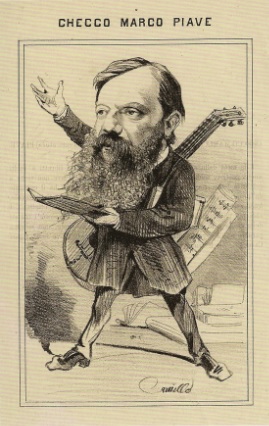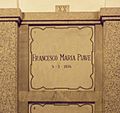Francesco Maria Piave facts for kids
Francesco Maria Piave (born May 18, 1810 – died March 5, 1876) was an Italian writer who created the words for operas, known as a librettist. He was born in Murano, a beautiful island near Venice, during a time when Italy was briefly part of Napoleon's empire.
Contents
A Busy Career
Piave worked for over twenty years with many famous composers of his time. He wrote librettos for Giovanni Pacini, Saverio Mercadante, Federico Ricci, and even Michael Balfe. But he is most famous for working with Giuseppe Verdi. Piave wrote 10 librettos for Verdi, including the very well-known operas Rigoletto and La traviata.
Piave was more than just a librettist. He was also a journalist, a translator, and he worked at the La Fenice opera house in Venice. There, he was the resident poet and stage manager, which is where he first met Verdi. Later, Verdi helped him get the same job at La Scala in Milan. Piave was very good at managing the stage and at talking to people, which helped Verdi a lot. However, Verdi was often very demanding with him.
Like Verdi, Piave was a strong Italian patriot. This means he loved his country and wanted it to be free. In 1848, during a time of fighting in Milan when Austrian troops left the city, Verdi even called Piave "Citizen Piave" in a letter. This showed their shared love for Italy.
Piave and Verdi worked on ten operas together between 1844 and 1862. Piave was even supposed to write the libretto for Aida in 1870. But he had a stroke, which made him unable to move or speak. Verdi helped Piave's wife and daughter after this. He suggested that famous composers create an album of music to sell and raise money for Piave. When Piave died nine years later in Milan at age 65, Verdi paid for his funeral and arranged for him to be buried at the Monumental Cemetery of Milan.
Piave's Librettos for Verdi
When Piave and Verdi started working together in 1844, Verdi began to have a much stronger say in how his operas were put together. Some experts say that Piave became like an instrument in Verdi's hands. This means Verdi had a very clear idea of what he wanted, and Piave helped him make it happen. Piave's librettos were perfect for Verdi's music because Verdi himself had a big part in shaping them.
Verdi wanted the story and the music to fit together perfectly. He wanted to control the whole dramatic flow of the opera. He no longer wanted to be limited by librettists who didn't share his vision, like Temistocle Solera, who wrote earlier librettos for him.
One example of how much Verdi pushed Piave was when they tried to get the opera Rigoletto approved by the censors in Venice. Censors were people who had to approve plays and operas before they could be performed. Verdi told Piave to do everything he could to get the story approved. He warned Piave not to let the matter drag on, saying Piave would be responsible if the opera wasn't allowed.
Despite Verdi's strong demands, Piave was very loyal to him. Even though Verdi sometimes had other people revise Piave's work, like for Simon Boccanegra, they remained true friends. Piave became someone Verdi truly cared about.
Piave wrote many important librettos for Verdi. After Salvadore Cammarano, Piave became Verdi's main librettist. Their first opera together was Ernani in 1844. Other famous ones include I due Foscari (1844), Attila (1846), Macbeth (1847), Il Corsaro (1848), Stiffelio (1850), Rigoletto (1851), La traviata (1853), Simon Boccanegra (1857), Aroldo (1857), and La forza del destino (1862). He also revised Macbeth in 1865.
Librettos by Piave
| Year | Title | Composer |
|---|---|---|
| 1842 | Il duca d'Alba | Giovanni Pacini (Libretto also used by Giovanni Peruzzini) |
| 1844 | Ernani | Giuseppe Verdi |
| 1844 | I due Foscari | Giuseppe Verdi |
| 1845 | Lorenzino de' Medici | Giovanni Pacini |
| 1846 | Attila | Giuseppe Verdi |
| 1846 | Estella di Murcia | Federico Ricci |
| 1847 | Griselda | Federico Ricci |
| 1847 | Macbeth (first version) | Giuseppe Verdi |
| 1847 | Tutti amanti | Carlo Romani |
| 1848 | Allan Cameron | Giovanni Pacini |
| 1848 | Giovanna di Fiandra | Carlo Boniforti |
| 1848 | Il corsaro | Giuseppe Verdi |
| 1848 | La Schiava Saracena | Saverio Mercadante |
| 1850 | Crispino e la comare | Luigi Ricci and Federico Ricci |
| 1850 | Elisabetta di Valois | Antonio Buzzolla |
| 1850 | Stiffelio | Giuseppe Verdi |
| 1851 | La Sposa di Murçia | Andrea Casalini |
| 1851 | Rigoletto | Giuseppe Verdi |
| 1853 | Baschina | Federico Guglielmo De Liguoro |
| 1853 | La donna delle isole | Giovanni Pacini |
| 1853 | La prigioniera | Carlo Ercole Bosoni |
| 1853 | La traviata | Giuseppe Verdi |
| 1854 | Margherita di Borgogna | Francesco Petrocini |
| 1854 | Pittore e Duca | Michael William Balfe |
| 1856 | I Fidanzati | Achille Peri |
| 1857 | Simon Boccanegra (first version) | Giuseppe Verdi |
| 1857 | Aroldo (revision of Stiffelio) | Giuseppe Verdi |
| 1857 | Vittore Pisani | Achille Peri |
| 1859 | Margherita la mendicante | Gaetano Braga |
| 1860 | La Biscaglina | Samuele Levi |
| 1861 | Guglielmo Shakspeare | Tomaso Benvenuti |
| 1862 | La forza del destino (first version) | Giuseppe Verdi |
| 1862 | Mormile | Gaetano Braga |
| 1862 | Rienzi | Achille Peri |
| 1865 | La Duchessa di Guisa | Paolo Serrao |
| 1865 | Macbeth (second version) | Giuseppe Verdi |
| 1865 | Rebecca | Bartolomeo Pisani |
| 1867 | Berta di Varnol | Giovanni Pacini |
| 1867 | Don Diego de Mendoza | Giovanni Pacini |
| 1868 | La tombola | Antonio Cagnoni |
| 1872 | Olema | Carlo Pedrotti |
Filmography
- Crispino e la comare, directed by Vincenzo Sorelli (1938)
- Rigoletto, directed by Carmine Gallone (1946)
- La signora delle camelie, directed by Carmine Gallone (1947)
- The Force of Destiny, directed by Carmine Gallone (1950)
- Rigoletto e la sua tragedia, directed by Flavio Calzavara (1956)
- La traviata, directed by Mario Lanfranchi (1968)
- Rigoletto, directed by Jean-Pierre Ponnelle (1982)
- La Traviata, directed by Franco Zeffirelli (1983)
- Macbeth, directed by Claude d'Anna (1987)
- Giuseppe Verdi's Rigoletto Story, directed by Gianfranco Fozzi (2005)
Images for kids
See also
 In Spanish: Francesco Maria Piave para niños
In Spanish: Francesco Maria Piave para niños




